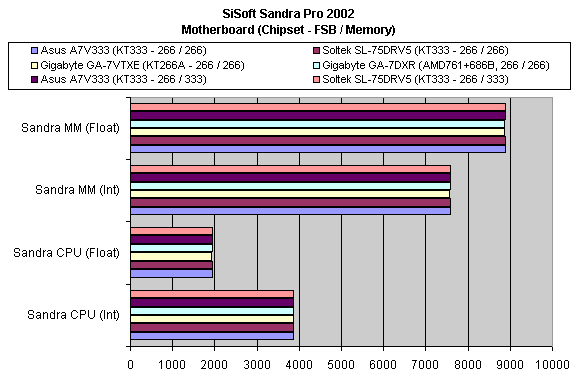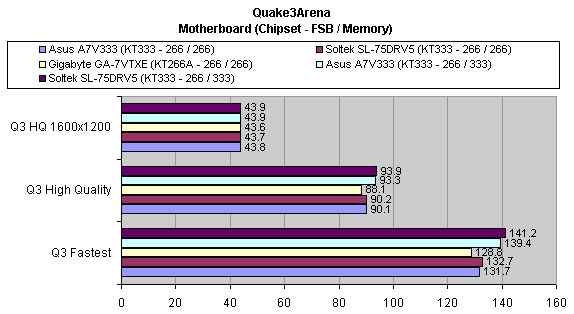|
|
Advertisement:
|
|
Asus A7V333 Review |
|
Join the community - in the OCAU Forums!
|
Performance Comparison
Performance:
We'll compare this Asus board to the Soltek KT333 board I reviewed earlier here. All testbed components and driver versions are the same as used for that motherboard, so we can carry the results over to this review. Representing KT266A, the predecessor chipset to KT333, we have Gigabyte's GA-7VTXE. We also have some results from a Gigabyte GA-7DXR, which uses the AMD761 North Bridge and VIA 686B South Bridge, representing the first generation of SocketA DDR motherboards.
Testbed Setup:- AMD AthlonXP 1600+ CPU
- Corsair XMS3000C2 (from Realtime-Systems) DDR SDRAM @ 266MHz @ CAS2 -or- @ 333MHz @ CAS2
- IBM 75GXP 30GB HDD
- X-Micro Impact T4600 (reviewed here) GF4 Ti4600 video card
- Enermax 550W PSU
- Win2K SP1
- DirectX 8.1
- VIA 4-in-1 438(2)v(a)
- DetonatorXP 28.32
The KT333 boards were run with their memory at 266MHz and then again with the memory at 333MHz. The KT266A and AMD761+686B boards cannot run their memory at 333MHz with the FSB at the stock 266MHz, so there is only a 266MHz result for them.
First up, Sisoft Sandra's CPU and MultiMedia benchmarks:

No great surprises there with all the boards scoring virtually identically. The higher memory setting makes no difference to this CPU-intensive benchmark.
Next, Sandra's Memory benchmark:

Here we can see a clear difference as the ancient AMD761+686B board lags behind. KT266A redeems itself well against KT333 when all boards are running their memory at 266MHz. Once the KT333's 333MHz memory support is enabled, they edge away from the KT266A board but it's not a big difference. Even smaller is the difference between the two KT333 motherboards - but the Asus is ever so slightly ahead.
We had a Big Brother election before the next benchmarks and the AMD761+686B board was voted off. No, I had some weird AGP stability issues with it, so only KT266A and KT333 progressed to the next round.
MadOnion's 3DMark2001SE is the standard DirectX benchmark:

id Software's Quake3Arena is still regarded as a useful OpenGL benchmark and a good "real world" gaming benchmark. Defaults were used for the "Fastest" and "High Quality" settings, but for "High Quality 1600x1200" as well as bumping up the resolution from the default 800x600 in the HQ test, we also changed Geometric Detail to Highest and dragged the Texture Detail slider to the maximum setting. Our in-house Slayer demo was used with Quake 1.31.

The last 2 sets of benchmarks show that 333MHz memory does produce a noticeable difference in benchmarks, but real world differences are tiny. You could get excited about the difference in Q3 Fastest, but nobody plays in that resolution. High Quality is a more realistic setting and there the difference is only 3-5FPS.
|
|
Advertisement:
All original content copyright James Rolfe.
All rights reserved. No reproduction allowed without written permission.
Interested in advertising on OCAU? Contact us for info.
|

|


